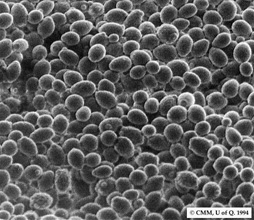




The Fungi kingdom includes mushrooms, yeasts and molds. They share common characteristics in that they do not depend on light and photosynthesis to sustain themselves, but they are very common organisms of the domain eukaryote. They are saprophytes, meaning that they secrete enzymes which digest organic matter. This is then absorbed as food, usually liquid.



(Left) Mold can grow rapidly on food that is left
unprotected. This is a bowl of chopped tomatoes. © S Hodges,
2000
(Center) Yeast Culture © 1999 The Centre for
Microscopy and Microanalysis
(Right) Mushrooms
The fungal kingdom is particularly resistant to changes in the environment and to harsh environmental conditions. They can survive dry and hot conditions that would put other eukaryote life-forms, in particular, under a lot of stress. The secret lies in their method of propagation, known as the spore. Fungal spores are tiny, usually spherical, capsules.
Fungi occur in all sizes of living organism. In fact, according to the Guinness Book of Records, the largest living organism known is a clonal-growth fungus Armillaria astoyae. It is located in forests of Washington State and inhabits an area of 1500 acres, mostly underground.
Fungi such as molds, can also be microscopic. Molds are a type of fungus that grows in microscopic filaments that are almost invisible. They often colonize new places by being carried on the air as microscopic spores. These are tough usually spherical bodies that are resilient to temperature, chemicals and other environmental hazards.
Molds like to grow in damp places where the airflow is still or only slight. Outdoors molds will grow on trees, in the ground and on rocks. They play an important role in recycling dead organic matter and are also foods to other types of organism.
In the home they can attack food, and damp food that is left for any period - in or out of the freezer - will almost certainly collect mold. The by-products of molds can be poisonous to other organisms. This is why we are told that eating moldy food is not a good idea. However, some food products such as cheese are actually produced by the action of mold, but here of course the conditions are very specific and non-toxic.
Yeasts are another form of fungi. They are a unicellular type that belongs to the phylum Ascomycetes. They have single nuclei and can reproduce both sexually and asexually. The latter is by budding or fission, and the former is by spore distribution. They play an important role in our lives, for they are used in bread-making and impart an attractive flavor to your daily loaf. They are also the main element in fermentation processes that produce wine and beer. Both baking and brewing are ancient processes used for thousands of years. Yeasts are used in the production of medical products and many other food-stuffs.
Fungi and yeasts can also attack the body causing disease. They cause the skin complaints, "athlete's foot", and "ringworm" as well as certain lung diseases, such as aspergillosis in the case of fungi, and conditions such as "thrush" in the case of yeasts.
Penicillin, the first antibiotic, was developed from the Penicillium notatum mold by Sir Alexander Fleming. Although penicillin derivatives are still in use, most antibiotics are now developed from bacterial strains.
Go
to
Home
| Space Station
| Mars | Rainforest
© 1999 Satellite Events Enterprises Inc.